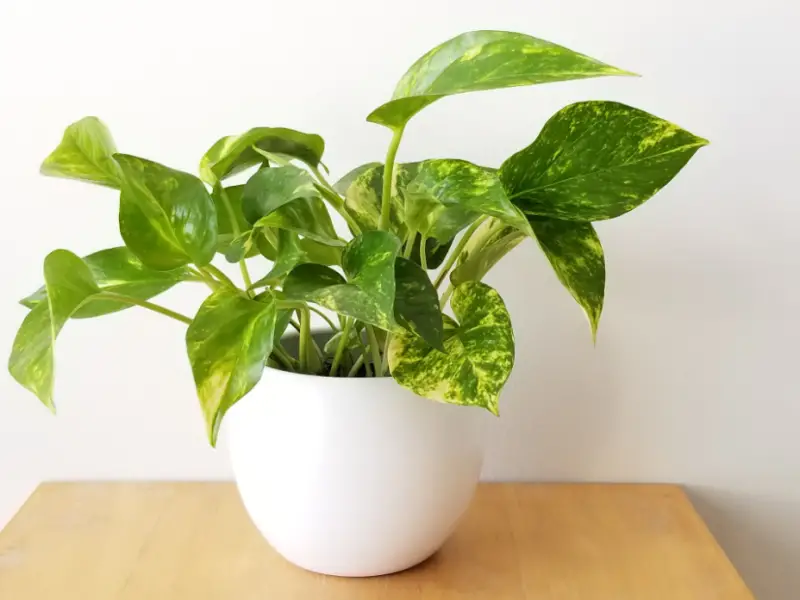Pothos (Epipremnum aureum), often referred to as Golden Pothos, is one of the most popular houseplants for both beginners and experienced plant enthusiasts alike. Known for its heart-shaped, variegated leaves, fast growth, and minimal care requirements, this tropical vine from the Solomon Islands is a must-have for your indoor garden. Whether you’re looking to train it to climb a support or let it cascade from a hanging basket, Pothos will thrive in a variety of settings with little maintenance.
Below is a comprehensive guide to growing and caring for this hardy plant, along with ultimate tips for keeping it lush and vibrant.
Overview of Golden Pothos

Common Names: Golden Pothos, Devil’s Ivy, Devil’s Vine
Botanical Name: Epipremnum aureum
Family: Araceae
Plant Type: Vine
Mature Size: 20–40 feet long, 3–6 feet wide
Sun Exposure: Bright, indirect light; tolerates low light
Soil Type: Well-draining, slightly acidic
Toxicity: Toxic to pets (dogs and cats)
Pothos are known for their adaptability, making them a versatile addition to any home. These plants grow quickly, often gaining 12 to 18 inches in a month under ideal conditions. The trailing vines of Pothos showcase their iconic heart-shaped green leaves that may be variegated with hues of white, yellow, or light green.
Light Requirements for Golden Pothos
Although Golden Pothos can tolerate low-light conditions, it thrives best in bright, indirect sunlight. This plant can adapt to fluorescent lighting, making it an excellent choice for offices or dimly lit rooms. If placed in too much shade, the variegation on the leaves may fade, turning them solid green. On the other hand, too much direct sunlight can scorch the leaves, causing them to become pale and limp. Ideally, place your Pothos near an east- or west-facing window for the perfect balance of light.
Soil and Potting Needs
For Pothos, a well-draining soil mix is essential. Standard houseplant potting mix or an aroid mix will provide the right environment for healthy root development. The plant prefers a slightly acidic soil pH between 6.1 to 6.8 but can tolerate neutral soils as well. Additionally, Pothos does not like to sit in waterlogged soil, so ensure that the pot has proper drainage.
Watering Tips
One of the most common mistakes in Pothos care is overwatering. The plant’s roots can easily rot if left in soggy soil. Allow the soil to dry out completely between waterings, usually about once every one to two weeks, depending on the season and humidity levels. Overwatering will show signs like black spots on leaves or the sudden collapse of the plant, while under-watering will result in droopy leaves. A good rule of thumb is to check the top inch of soil; if it’s dry, it’s time to water.
Temperature and Humidity
Golden Pothos grows best in temperatures between 65°F and 75°F but can tolerate a range as low as 50°F. This plant is tropical by nature and enjoys high humidity but can adapt to low-humidity conditions typical of most indoor environments. For an extra boost, you can place the plant in a naturally humid area like a bathroom or group it with other tropical plants to create a humid microclimate.
Fertilizing Golden Pothos
While Pothos isn’t a heavy feeder, it will benefit from occasional feeding during its growing season, which spans spring and summer. Use a balanced houseplant fertilizer once a month to support vigorous growth. Be careful not to over-fertilize, especially in the winter months when the plant’s growth slows down.
Pruning for Health and Shape
Golden Pothos is known for its rapid growth, and without pruning, it can quickly become leggy. Regular pruning encourages a bushier, fuller look. Trim the plant just below a node, and always leave at least two leaf nodes on each vine you cut. You can prune at any time during the growing season, but avoid pruning when the plant is dormant in winter. This pruning method also offers the perfect opportunity for propagation (which we’ll discuss shortly).
Common Varieties of Pothos
There are several varieties of Pothos, each with unique leaf patterns and colors:
- Marble Queen Pothos: Known for its stunning white-and-green variegation, this variety requires more light to maintain its color.
- Neon Pothos: Featuring bright chartreuse leaves, the Neon Pothos brings a pop of color to low-light areas.
- Pearls and Jade Pothos: This variety displays gray, green, and white variegation around the edges of the leaves.
- Silver Satin Pothos: With thick, gray-green leaves speckled with silver, this variety is drought-tolerant and thrives in low-light conditions.
Propagation of Golden Pothos
One of the best aspects of Golden Pothos is how easily it can be propagated. Simply take a stem cutting with at least three leaves, remove the bottom leaf, and place the cutting in water. Roots will begin to form within one to two weeks, and once they’re a few inches long, you can transfer the cutting to a pot with soil. Keep the soil moist but not soggy while the plant is establishing its roots.
Potting and Repotting
Over time, Pothos can become pot-bound, meaning its roots outgrow the container. Signs that your Pothos needs repotting include droopy leaves and roots growing through the drainage holes. Repot the plant into a slightly larger container, providing it with fresh soil to support its growth. Choose a pot with good drainage to prevent root rot.
Dealing with Pests and Diseases
Though hardy, Pothos can sometimes fall prey to common houseplant pests like spider mites, whiteflies, scales, and mealybugs. Regularly inspecting the leaves and stems for pests can help catch infestations early. You can wipe the leaves with a damp cloth or use neem oil or insecticidal soap for larger infestations.
Diseases like root rot or bacterial leaf spot can be avoided by ensuring proper watering practices and providing adequate light. Overwatering and poor drainage are often the culprits behind these problems. If root rot occurs, trim back the damaged roots and repot the plant in fresh soil.
Common Problems and Solutions
- Yellow Leaves: While a few yellow leaves are normal, widespread yellowing can indicate overwatering or disease.
- Browning Leaves: Brown, crispy leaves are usually a sign of underwatering or insufficient humidity.
- Drooping Leaves: Drooping can signal dehydration or that the plant is pot-bound.
Essential Tips for Thriving Pothos
- Lighting: Keep your Pothos in bright, indirect light to maintain variegation.
- Watering: Let the soil dry out between waterings to avoid root rot.
- Pruning and Propagation: Prune regularly to encourage fullness and propagate easily using stem cuttings.
- Humidity: Increase humidity for lusher growth, but the plant will tolerate standard indoor conditions.
Conclusion
Golden Pothos is a fantastic plant for any home due to its beauty, hardiness, and ease of care. Whether you’re a beginner or a seasoned plant parent, the Pothos will reward you with vibrant growth, especially when you follow these ultimate care tips. Its ability to adapt to various light conditions, along with minimal watering requirements, makes it an excellent choice for those with busy lifestyles or anyone looking to brighten up their living space.
Embrace the simplicity and beauty of Pothos, and watch it thrive in your home!






